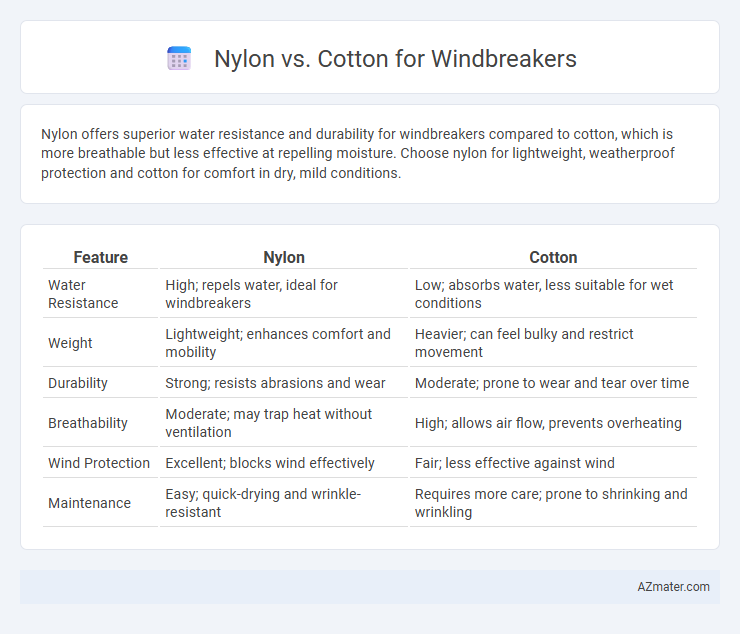Nylon offers superior water resistance and durability for windbreakers compared to cotton, which is more breathable but less effective at repelling moisture. Choose nylon for lightweight, weatherproof protection and cotton for comfort in dry, mild conditions.
Table of Comparison
| Feature | Nylon | Cotton |
|---|---|---|
| Water Resistance | High; repels water, ideal for windbreakers | Low; absorbs water, less suitable for wet conditions |
| Weight | Lightweight; enhances comfort and mobility | Heavier; can feel bulky and restrict movement |
| Durability | Strong; resists abrasions and wear | Moderate; prone to wear and tear over time |
| Breathability | Moderate; may trap heat without ventilation | High; allows air flow, prevents overheating |
| Wind Protection | Excellent; blocks wind effectively | Fair; less effective against wind |
| Maintenance | Easy; quick-drying and wrinkle-resistant | Requires more care; prone to shrinking and wrinkling |
Introduction: Choosing the Right Windbreaker Fabric
Nylon offers superior water resistance and windproof capabilities, making it ideal for windbreakers designed to protect against harsh weather conditions. Cotton provides breathability and softness but lacks durability and moisture resistance, which may compromise performance in wet or windy environments. Selecting the right windbreaker fabric depends on prioritizing weather protection, weight, and comfort for your specific outdoor activities.
Overview of Nylon and Cotton Materials
Nylon is a synthetic polymer known for its lightweight, water-resistant, and durable properties, making it ideal for windbreakers designed to repel moisture and withstand abrasion. Cotton, a natural fiber, offers breathability and comfort but tends to absorb water and lose insulating ability when wet. These material characteristics influence the performance and maintenance of windbreakers in various weather conditions.
Durability: Nylon vs Cotton Windbreakers
Nylon windbreakers exhibit superior durability compared to cotton due to their resistance to abrasions, tears, and mildew, making them ideal for harsh weather conditions and outdoor activities. Cotton windbreakers, though breathable and comfortable, tend to wear out faster when exposed to moisture and repetitive friction, often losing shape and strength. The synthetic fibers in nylon provide enhanced tensile strength and longevity, ensuring windbreakers retain their protective qualities over extended use.
Weather Resistance and Water Repellency
Nylon windbreakers outperform cotton in weather resistance due to their tightly woven synthetic fibers that prevent wind penetration and provide superior water repellency through durable water-repellent (DWR) coatings. Cotton, while breathable, absorbs moisture quickly and loses insulating properties when wet, making it less effective in rainy or windy conditions. For optimal protection against wind and rain, nylon is the preferred material due to its lightweight durability and hydrophobic characteristics.
Breathability and Comfort Comparison
Nylon windbreakers offer superior water resistance and lightweight durability but often lack the breathability found in cotton fabrics, which naturally allow better air circulation and moisture absorption. Cotton windbreakers deliver enhanced comfort due to their softness and ability to wick sweat away, making them ideal for moderate activities where ventilation is crucial. However, nylon's quick-drying properties outperform cotton in wet conditions, providing a balance between breathability and protection.
Weight and Packability of Nylon and Cotton
Nylon windbreakers are significantly lighter and more packable than cotton, making them ideal for outdoor activities where minimizing bulk is crucial. Nylon's synthetic fibers compress easily without losing shape, allowing it to fold into compact sizes suitable for backpack storage or travel. Cotton, being denser and less flexible, tends to retain moisture and bulk, resulting in heavier garments that are less convenient to pack and carry.
Style and Aesthetic Appeal
Nylon windbreakers boast a sleek, shiny finish that enhances a sporty and modern style, making them ideal for activewear and streetwear enthusiasts. Cotton windbreakers offer a matte, natural texture that appeals to those seeking a casual, vintage-inspired aesthetic with a softer drape. The choice between nylon and cotton influences not only durability and weather resistance but also the overall visual impression and tactile experience of the windbreaker.
Maintenance and Care Requirements
Nylon windbreakers require minimal maintenance due to their quick-drying and water-resistant properties, making them easy to clean with mild detergent and air drying. Cotton windbreakers demand more care as they tend to absorb moisture, leading to longer drying times and the potential for shrinkage or color fading if not washed properly in cold water and dried flat. Proper maintenance ensures durability and performance, with nylon favored for active use and cotton preferred for comfort and breathability.
Environmental Impact and Sustainability
Nylon windbreakers are derived from petrochemicals, resulting in higher carbon emissions and lower biodegradability compared to cotton. Cotton, especially organic varieties, is renewable and biodegradable but requires substantial water and pesticide use, impacting sustainability. Innovations like recycled nylon and organic cotton cultivation improve environmental footprints, making material choice critical for eco-conscious windbreaker production.
Conclusion: Which Material Is Best for Windbreakers?
Nylon is the best material for windbreakers due to its superior wind resistance, lightweight nature, and water-repellent properties, making it ideal for outdoor activities and unpredictable weather. Cotton, while breathable and comfortable, absorbs moisture and dries slowly, reducing its effectiveness in blocking wind and protecting against rain. For optimal performance and durability, nylon windbreakers are preferred by athletes and outdoor enthusiasts.

Infographic: Nylon vs Cotton for Windbreaker
 azmater.com
azmater.com